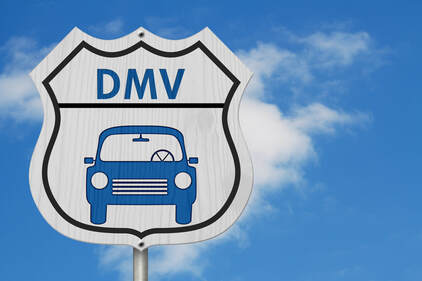What is visual acuity?
A visual acuity test is an eye exam that checks how well you see the details of a letter or symbol from a specific distance. The standard for normal vision is 20/20. If your vision is measured at 20/40 or 20/60, it means that your vision is worse than 20/20. With 20/40 vision, you need to be at a distance of 20 feet in order to see what someone with normal vision can see at 40 feet.
Ohio driving requirements
In order to drive without corrective lenses, like glasses or contacts, you must have 20/70 or better vision during the day. Nighttime driving requires 20/40 or better vision. If you need corrective lenses to reach the vision requirements, you must wear them at all times while driving.
Restricted Licenses:
If your vision is worse than 20/40 but not worse than 20/70 you may be able to get a license that restricts you to drive during the day only. Telescopic lenses may not be used to meet the above standards.
Vision in One Eye Only:
People who have only one eye, or have vision in only one eye have additional requirements. These requirements include 20/30 vision in the good eye for an unrestricted license and at least 20/60 in the good eye for daytime driving.
Other Considerations:
In order to drive, you must also meet field of vision requirements. Your horizontal visual field must be 70 degrees wide on both sides of the fixation point in order to qualify for a non-restricted drivers license. Your visual field is measured by how well you see in your peripheral vision, while your eyes are focused forward. If your visual field on one side is less than 70 degrees, you must have at least seventy degrees on one side of fixation and forty-five degrees on the other side of fixation, and use an outside mirror on the side of the more limited visual field, in addition to an inside mirror.
If you drive professionally, like a school bus driver, you must have binocular vision, the field of vision must be 70 degrees in each eye, and you must be able to identify colors used in traffic signals and signs: red, green and amber; and you must see 20/40 or better.
Restricted Licenses:
If your vision is worse than 20/40 but not worse than 20/70 you may be able to get a license that restricts you to drive during the day only. Telescopic lenses may not be used to meet the above standards.
Vision in One Eye Only:
People who have only one eye, or have vision in only one eye have additional requirements. These requirements include 20/30 vision in the good eye for an unrestricted license and at least 20/60 in the good eye for daytime driving.
Other Considerations:
In order to drive, you must also meet field of vision requirements. Your horizontal visual field must be 70 degrees wide on both sides of the fixation point in order to qualify for a non-restricted drivers license. Your visual field is measured by how well you see in your peripheral vision, while your eyes are focused forward. If your visual field on one side is less than 70 degrees, you must have at least seventy degrees on one side of fixation and forty-five degrees on the other side of fixation, and use an outside mirror on the side of the more limited visual field, in addition to an inside mirror.
If you drive professionally, like a school bus driver, you must have binocular vision, the field of vision must be 70 degrees in each eye, and you must be able to identify colors used in traffic signals and signs: red, green and amber; and you must see 20/40 or better.
pennsylvania driving requirements
In order to drive without corrective lenses, like glasses or contacts, you must have 20/70 or better vision during the day. Nighttime driving requires 20/40 or better vision. If you need corrective lenses to reach the vision requirements, you must wear them at all times while driving.
Restricted Licenses:
If your vision can only be corrected to 20/60, and a recommendation has been made by a licensed physician, you may be able to get a license that restricts you to drive during the day only. If your vision can only be corrected to between 20/70 and 20/100, and a recommendation has been made by a licensed physician, you may be eligible for a restricted license that would prohibit driving on freeways and highways and at night. Restricted licensees may need to pass a vision test yearly. In addition you may be limited to driving within a specific geographic area, and may have your license suspended if involved in one at-fault crash or receive two moving violations during a 1-year period. Telescopic lenses may not be used to meet the above standards.
Vision in One Eye Only:
People who have only one eye, or have vision in only one eye have additional requirements. These requirements include 20/40 vision in the good eye. The vehicle must be equipped with mirrors or cameras that allow the driver to see 200 feet to the rear.
Other Considerations:
In order to drive, you must also meet field of vision requirements. Your horizontal visual field must be 120 degrees wide in order to qualify for a drivers license.
If you drive professionally, like a school bus driver, you must have binocular vision, the field of vision must be 160 degrees, and you must be able to identify colors used in traffic signals and signs: red, green and amber; and you must see 20/40 or better.
Restricted Licenses:
If your vision can only be corrected to 20/60, and a recommendation has been made by a licensed physician, you may be able to get a license that restricts you to drive during the day only. If your vision can only be corrected to between 20/70 and 20/100, and a recommendation has been made by a licensed physician, you may be eligible for a restricted license that would prohibit driving on freeways and highways and at night. Restricted licensees may need to pass a vision test yearly. In addition you may be limited to driving within a specific geographic area, and may have your license suspended if involved in one at-fault crash or receive two moving violations during a 1-year period. Telescopic lenses may not be used to meet the above standards.
Vision in One Eye Only:
People who have only one eye, or have vision in only one eye have additional requirements. These requirements include 20/40 vision in the good eye. The vehicle must be equipped with mirrors or cameras that allow the driver to see 200 feet to the rear.
Other Considerations:
In order to drive, you must also meet field of vision requirements. Your horizontal visual field must be 120 degrees wide in order to qualify for a drivers license.
If you drive professionally, like a school bus driver, you must have binocular vision, the field of vision must be 160 degrees, and you must be able to identify colors used in traffic signals and signs: red, green and amber; and you must see 20/40 or better.
The information here is designed to give you a quick summary of driving vision requirements to help keep yourself and others safe on the road. For further information or clarification, please contact your state's motor vehicle department.
Complete Primary Eyecare
Hubbard Centre One
30 N Main Street Hubbard, OH 44425 |
Hours
Monday: 8:00 am - 4:30 pm Tuesday: 8:00 am - 4:30 pm Wednesday: 8:00 am - 4:30 pm Thursday: 8:00 am - 4:30 pm Friday: By appointment only Saturday: Closed Sunday: Closed |




